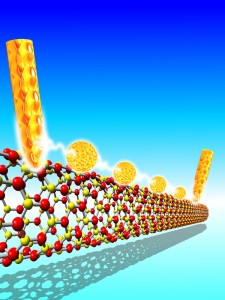 Members of the High Altitute Water Cherenkov (HAWC) Gamma-Ray Observatory met at Michigan Tech on September 23-25, 2013. The meeting was attended by about 60 international members. The meeting was coordinated by Assistant Professor of Physics Petra H. Huentemeyer.
Members of the High Altitute Water Cherenkov (HAWC) Gamma-Ray Observatory met at Michigan Tech on September 23-25, 2013. The meeting was attended by about 60 international members. The meeting was coordinated by Assistant Professor of Physics Petra H. Huentemeyer.
 Professors John Jaszczak (Physics) and Paul Bergstrom (ECE), with PhD students Madhusudan Savaikar and Douglas Banyai, published a paper, “Simulation of charge transport in multi-island tunneling devices: Application to disordered one-dimensional systems at low and high biases” in the latest issue of Journal of Applied Physics (vol. 114 issue 11).
Professors John Jaszczak (Physics) and Paul Bergstrom (ECE), with PhD students Madhusudan Savaikar and Douglas Banyai, published a paper, “Simulation of charge transport in multi-island tunneling devices: Application to disordered one-dimensional systems at low and high biases” in the latest issue of Journal of Applied Physics (vol. 114 issue 11).

Recent work published by Professor Yoke Khin Yap (Physics) on transistors without semiconductors has gained attention at the Center for Nanophase Materials Sciences (CNMS) at Oak Ridge National Laboratory (ORNL). Yap’s work “Room Temperature Tunneling Behaviors of Boron Nitride Nanotubes Functionalized with Gold Quantum Dots,” first appeared in CNMS Research Highlights, and then later in the September issue of the CNMS User Newsletter.
This work is now being highlighted by Dr. Sean Smith, Director of CNMS, during his overview talk in the Triennial Review of CNMS. The triennial review is being held on September 24-26, 2013 at CNMS as attended by the review team of the U.S. Department of Energy, the CNMS Advisory Committee Review Panel, and scientists in CNMS.
On September 25, Professor Yap presented an invited talk entitled “Transistors without semiconductors: tunneling behavior of functional boron nitride nanotubes” during the review. The highlights are related to a Yap article recently published in Volume 25, Issue 33/2013, pages 4544-4548 of Advanced Materials (http://onlinelibrary.wiley.com/doi/10.1002/adma.201301339/abstract).
Yap’s coauthors include Professor John Jaszczak, research scientist Dongyan Zhang, postdoctoral researchers Chee Huei Lee and Jiesheng Wang, and graduate students Madhusudan A. Savaikar, Boyi Hao and Douglas Banyai of Michigan Tech; Shengyong Qin, Kendal W. Clark and An-Ping Li of the Center for Nanophase Materials Sciences at ORNL; and Juan-Carlos Idrobo of the Materials Science and Technology Division of ORNL.
 Title: Intrinsic Correlations of Quantum Lights in Macroscopic Environments
Title: Intrinsic Correlations of Quantum Lights in Macroscopic Environments
Advisor: Dr. Kim Fook Lee
Co-Advisor: Dr. Jacek Borysow
Quantum Information Science (QIS) is an up-and-coming field that exploits the peculiar properties of quantum superposition and entanglement by using quantum objects, such as atoms, molecules, photons and phonons. As photons interact weakly with their environment and are very robust against environmental disturbance, they are considered the most promising candidates for the applications of QIS. The preservation of intrinsic quantum properties of light in macroscopic environments will be the key for practical realization of QIS. For my Ph.D. research, I’m working with different quantum light sources, spanning from single photon systems such as entangled photons to millions of photons such as weak coherent light. I study the intrinsic correlations of quantum light in macroscopic environments, while mainly concerned with their applications in quantum metrology and communications.
by Yong Meng Sua
References:
- Y. M. Sua, J. Malowicki, and K. F. Lee, “Quantum Correlation of Telecom Wavelength Photon-pair through Multiple Scattering Media,” in The Rochester Conferences on Coherence and Quantum Optics and the Quantum Information and Measurement meeting, OSA Technical Digest (online) (Optical Society of America, 2013), paper W6.27.
- Y. M. Su, J. Malowicki, M. Hirano, and K. F. Lee, “Generation of high purity entangled photon-pair in a short highly non-linear fiber,” Optics Letters, 38, 73-75 (2013)
- Y. M. Sua and K. F. Lee, “Macroscopic mechanical correlations using single-photon spatial compass state and operational Wigner function,” Phys. Rev. A 85, 062113 (2012).
- Y. M. Sua, E. Scanlon, T. Beaulieu, V. Bollen, and K. F. Lee, “Intrinsic quantum correlations of weak coherent states for quantum communication,” Phys. Rev. A 83, 030302(R) (2011).
 “A Minimalist Approach to Modeling Complex Arctic Clouds” was submitted by Dr. Raymond Shaw to Research Highlights in Atmospheric System Research (ASR), US Department of Energy. The highlight is based on the publication Yang F, M Ovchinnikov, and RA Shaw. 2013. “Minimalist model of ice microphysics in mixed-phase stratiform clouds.” Geophysical Research Letters, 40(14), doi:10.1002/grl.50700. The highlight concerns mixed-phase stratiform clouds, which are common features in the Arctic environment.
“A Minimalist Approach to Modeling Complex Arctic Clouds” was submitted by Dr. Raymond Shaw to Research Highlights in Atmospheric System Research (ASR), US Department of Energy. The highlight is based on the publication Yang F, M Ovchinnikov, and RA Shaw. 2013. “Minimalist model of ice microphysics in mixed-phase stratiform clouds.” Geophysical Research Letters, 40(14), doi:10.1002/grl.50700. The highlight concerns mixed-phase stratiform clouds, which are common features in the Arctic environment.
Read more at ASR Research Highlights.

Since it was published online in Advanced Materials, the article “Room-Temperature Tunneling Behavior of Boron Nitride Nanotubes Functionalized with Gold Quantum Dots,” coauthored by physics professor Yoke Khin Yap, has received exceptional attention. The related new release, “Beyond Silicon: Transistors without Semiconductors,” appeared in numerous websites and blogs. The Altmetric system, which measures the social impact of a scholarly literature, gave it a score of 86.
The article has scored higher than all articles from Advanced Materials published within six weeks on either side of its publication date. Articles from this journal typically receive more attention than average, with a mean Altmetric score of 7.1 compared to the global average of 3.8. This article’s score places in the 99th percentile of the 1.4 million articles across all journals tracked by Altmetric.
Yap’s article also highlighted in a number of professional societies, including IEEE Spectrum of the Institute of Electrical and Electronics Engineers , Ceramic Tech Today from the American Ceramic Society, and the Center for Nanophase Materials Sciences in Oak Ridge National Laboratory.
The researchers’ work is described in the article “Room Temperature Tunneling Behavior of Boron Nitride Nanotubes Functionalized with Gold Quantum Dots,” and published in issue 33/2013, pages 4544-4548 of Advanced Materials. In addition to Yap, coauthors include Professor John Jaszczak, research scientist Dongyan Zhang, postdoctoral researchers Chee Huei Lee and Jiesheng Wang, and graduate students Madhusudan A. Savaikar, Boyi Hao and Douglas Banyai of Michigan Tech; Shengyong Qin, Kendal W. Clark and An-Ping Li of the Center for Nanophase Materials Sciences at ORNL; and Juan-Carlos Idrobo of the Materials Science and Technology Division of ORNL. The work was funded by the Office of Basic Energy Sciences of the US Department of Energy (Award # DE-FG02-06ER46294, PI:Y.K.Yap) and was conducted in part at ORNL (Projects CNMS2009-213 and CNMS2012-083, PI: Y.K.Yap).


I am a graduate student working under Dr. Claudio Mazzoleni in the Environmental Optics Laboratory (EOL) at Michigan Tech. Currently I am studying the absorption spectra of water vapor to determine the appropriate transition lines suitable for my experiment. Water vapor is a critical gas present in the atmosphere in variable amounts that absorbs in various wavelength regions from the far infrared to the UV region. This results in hundreds of band spectra and thousands of transition lines. I am using the HITRAN database to simulate and select the optimal lines for my study using a Tunable Diode Laser. I am working to develop an instrument that can monitor the water vapor concentration in the Cloud chamber soon to be installed at Michigan Tech. Before stepping into this experiment, I studied the absorption band of CO2 using a tunable diode laser.
I have also been working on the development of a Quartz-Enhanced Photoacoustic Spectroscopy system. A piezo-electric quartz tuning fork has been successfully utilized in photoacoustic spectroscopy in a gas filled resonator for the study of light absorption by gases. Our group is determined to extend this technique to measure aerosol absorption in real world situations.
by Janarjan Bhandari
References:
Reliable optical measurement of water vapor in highly scattering environment, Park et.al (2009) Spectrochimica Acta Part A: Molecular and Biomolecular Spectroscopy
Quartz-enhanced photoacoustic spectroscopy, Kosterev et.al (2002) Optics Letters
 Physics alum Nathan Hinkley ’09 is the first author in a Science Express publication entitled “An Atomic Clock with 10-18 Instability”. The paper was picked up by several news outlets, including Scientific Computing, LA Times Science Now, Photonics.com, and National Public Radio.
Physics alum Nathan Hinkley ’09 is the first author in a Science Express publication entitled “An Atomic Clock with 10-18 Instability”. The paper was picked up by several news outlets, including Scientific Computing, LA Times Science Now, Photonics.com, and National Public Radio.
Petra Huentemeyer (Physics) has been awarded a $156,750 research grant, the first year of a potential three-year $470,250 project, for “Studying Cosmic-Ray Acceleration and Propagation, Gas Content and Interstellar Radiation Fields in our Galaxy with the HAWC Observatory” from the National Science Foundation.
From Tech Today.

Mutli-scale modeling of nanoparticle based transistors
For half a century the integrated circuits (ICs) that make up the heart of electronic devices have been steadily improving by shrinking at an exponential rate. However, as the current crop of ICs get smaller and the insulating layers involved become thinner, electrons leak through due to quantum mechanical tunneling. This is one of several issues which will bring an end to the party, after which future improvements will have to come from employing fundamentally different transistor architecture rather than fine tuning and miniaturizing the field effect transistors in use today.
Several new transistor designs, some designed and built here at Tech, involve electrons tunneling their way through arrays of nanoparticles. We use a multi-scale approach to model these devices and study their behavior. For the smallest details of how often electrons jump from one particular nanoparticle to another, we use a first principles approach (density functional theory) to study the quantum mechanics involved. To estimate the change in energy due to the movement of a single electron, we use the finite element method to calculate electrostatic capacitances. The kinetic Monte Carlo method allows us to use our knowledge of these details to simulate an entire device — sometimes consisting of hundreds of individual particles — and watch as a device ‘turns on’ and starts conducting an electric current. Finally, we are developing new algorithms that will allow us to simulate the collective behavior of thousands of devices.
This work is ongoing under the advisement of Dr. John Jaszczak, in collaboration with the research groups of Dr. Pandey, Dr. Bergstrom, and Dr. Yap, and with support from the Miles fellowship.
